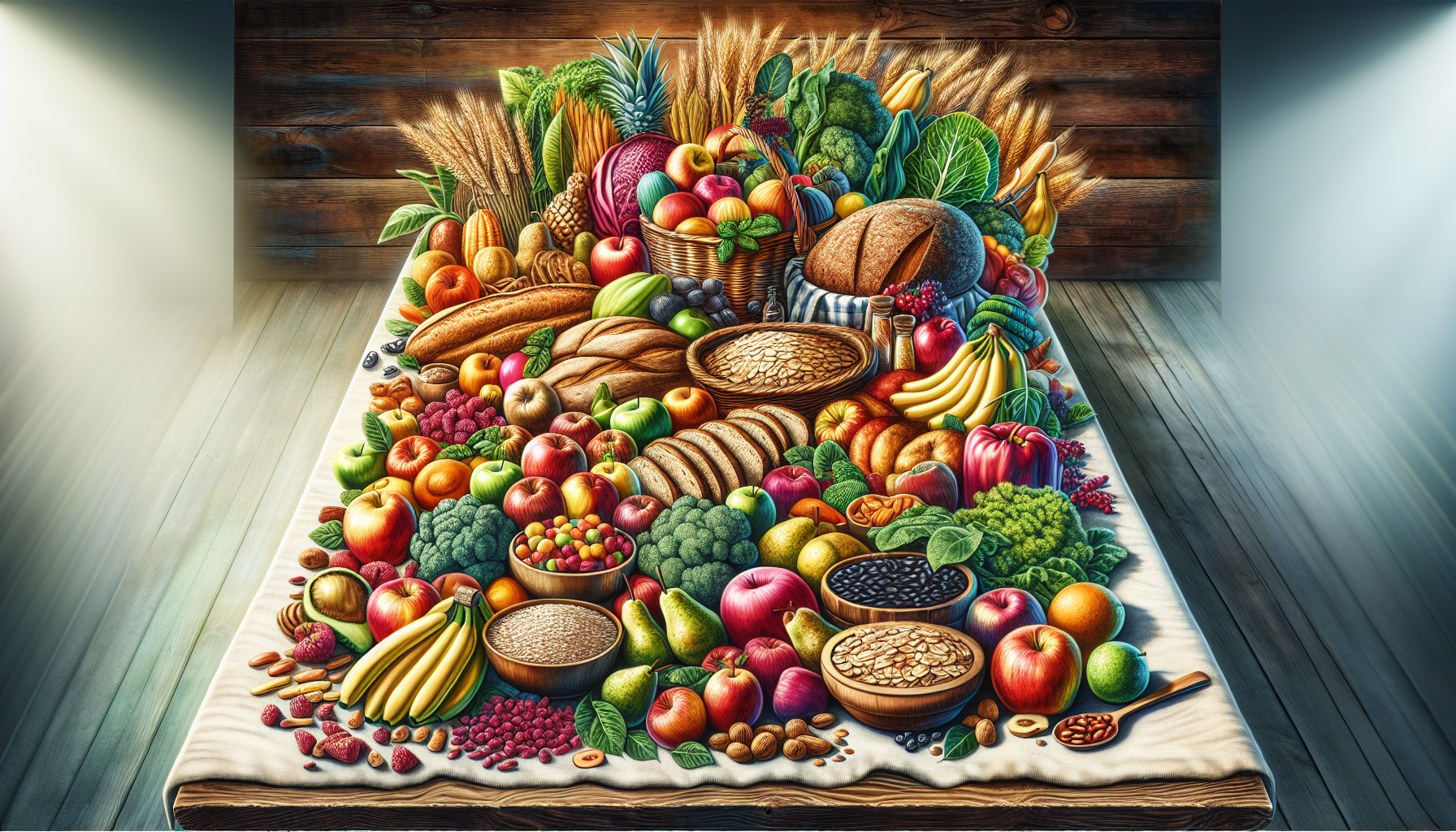Unlocking the Power of Fiber: Your Guide to a Healthier Diet
Embarking on the journey through the dietary fiber landscape can be simple and enlightening. This guide aims to simplify the complexities of dietary fiber and its role in health, offering easy-to-implement strategies for incorporating more fiber-rich foods into your diet. You'll learn about the essence of fiber, its health advantages, and actionable tips for enhancing your meals with a fiber-rich touch.
Key Takeaways
Dietary fiber, essential for digestion and overall health, is categorized into soluble and insoluble types, found in plant-based foods like fruits, vegetables, and whole grains.
High-fiber foods contribute to reduced risk of chronic diseases, support digestive health, manage weight, and regulate blood sugar levels.
To meet the recommended intake of 25 to 35 grams of fiber daily, meal planning should include a variety of high-fiber foods and any dietary changes should be made gradually to avoid digestive distress.
Understanding Dietary Fiber
Dietary fiber, a non-digestible carbohydrate, is an important component of our diets with two primary forms: soluble and insoluble fibers. These dietary fibres are vital for your digestive tract health. Imagine soluble dietary fibers being like sponges that soak up water to create a gel-like material which slows down digestion. Conversely, insoluble fiber functions as a broomstick sweeping through your digestive system and helps in forming bulkier stools, facilitating better digestion. Adding dietary fiber into your daily diet can markedly enhance overall well-being.
Fortunately, both varieties of high-fiber content can be found in many appetizing plant-based options such as fruits, vegetables, and whole grains. By incorporating these high-fiber foods into your meals regularly, not only does one’s intake of dietary fibre intake increase, but it also encourages the adoption of healthier eating habits.
The Importance of High-Fiber Foods
Having defined dietary fiber, we now delve into its crucial role within our nutritional regimen. Foods high in fiber are essential for a well-rounded diet and contribute significantly to our general well-being. A diet rich in high-fiber foods can diminish the likelihood of encountering chronic ailments and lifestyle related factors such as:
Heart disease
Diabetes Type 2
Select forms of cancer
Obesity
Consuming these nutrient-dense, fibrous edibles promotes digestive wellness while also having the potential to bring down cholesterol levels.
Fruits and Vegetables
Embarking on a high fiber diet, fruits and vegetables stand as essential components of healthy diet due to their abundant soluble and insoluble dietary fiber content. They are crucial for achieving a well-rounded diet. Among the fruit selections with notable fiber content are:
Pears
Strawberries
Avocados
Apples
Raspberries
Likewise, vegetables also offer impressive amounts of dietary fiber. Several vegetable options that feature rich fiber profiles include:
Carrots
Beets
Broccoli
Artichokes
Brussels sprouts
Incorporating an assortment of plant foods like these fruits and vegetables into your daily menu can greatly increase your intake of dietary fiber while delivering myriad health benefits associated with it.
Whole Grains
Opting for whole grains is a superior choice when selecting grain-based foods. Rich in fiber, whole options like brown rice, barley, and quinoa surpass their refined versions in nutritional value. The anatomy of each grain kernel consists of the bran, germ, and endosperm. It’s this trio that comprises whole grains and bestows an array of nutrients including fiber along with B vitamins, antioxidants, and phytochemicals.
Including whole grains as part of your diet not only augments your intake of fiber, but also equips your body with vital nutrients necessary for maintaining peak health conditions. Thus whenever you’re picking out bread or choosing pasta at the store, ensure to select products made from whole grains.
Nuts and Seeds
Despite their modest size, nuts and seeds are densely packed with nutrients. High in fiber, they are an essential component of a nutritious diet. Beyond their high fiber content, these mini nutritional gems—including almonds and chia seeds—are loaded with wholesome fats, vitamin E, and magnesium.
Even though nuts and seeds have a higher calorie count, the substantial amount of fiber found within them aids in promoting satiety and fullness which can help prevent excessive eating. By incorporating a small portion of nuts or by sprinkling some seeds over your salads or yogurt dishes, not only enhances taste, but also contributes significantly to maintaining a well-rounded diet rich in fibers.
The Science Behind Fiber's Health Benefits
Recognize the scientific insights revealing the numerous health advantages of dietary fiber. Fiber is far from an inert traveler through our system. It actively participates by enhancing gut motility, diminishing colorectal cancer risks, and fostering a hospitable environment for positive gut microbiota.
Gut Health and Digestion
Let’s dive in. In the advantages of consuming high fiber foods for your digestive system. Including a variety of fiber-rich items in your diet, such as fruits, vegetables, whole grains, and legumes, is essential to help prevent constipation. Dietary fiber significantly contributes to enhancing the volume and softness of stool, which promotes better movement through the gut while reducing the the risk factor of developing problems like constipation or diarrhea.
Beyond simply aiding with bowel consistency, dietary fiber plays an important role in maintaining a healthy gut environment by positively affecting microbial balance and fostering good bacterial growth within the intestines — all due to its capacity for generating short chain fatty acids.
It’s vital not to overlook hydration when increasing your intake of fibrous foods. Adequate fluid consumption is key in preserving digestive wellness and avoiding potential issues such as constipation that may arise with a higher fibre diet.
Weight Management
Achieving and preserving a healthy body weight is a common aspiration, in clinical nutrition, with dietary fiber serving as an important contributor to this objective. The inclusion of high fiber in one’s diet aids both appetite management and the pursuit of weight loss, assisting individuals in maintaining an optimal body weight.
The following points illustrate how eating foods rich in dietary fiber can bolster efforts toward weight control:
Foods that are high in fiber tend to be more filling, which may lead to decreased overall food intake.
High-fiber foods aid in regulating hunger and satiety signals, enabling prolonged sensations of fullness.
Dietary fiber decelerates the digestion process. This helps maintain steady blood sugar levels and mitigates insulin spikes.
By integrating foods abundant with dietary fiber into your meal planning, you actively support your journey toward shedding excess pounds while fostering sustainable body weight management.
Because high-fiber nourishment often contains fewer calories for their volume when juxtaposed against options low in fiber content. This aspect promotes calorie consumption moderation - another cornerstone strategy for achieving long-term equilibrium between caloric input-output thereby ensuring wholesome physical conditioning.
Blood Sugar Regulation
Dietary soluble fiber offers benefits beyond aiding in digestion. It is vital for maintaining stable blood sugar levels. By decelerating the absorption of glucose, soluble fibers prevent sharp increases in blood sugar that typically follow a meal rich in carbohydrates. Consuming foods with high concentrations of viscous soluble fibers, such as oats, can mitigate these surges in blood sugar and lower the chance of carbs elevating your blood sugar to dangerous levels.
Incorporating whole grains into your meals — especially those abundant in beta glucan like oats — helps to moderate the breakdown of starches into glucose. This contributes significantly to sustained control over blood sugar and diminishes diabetes risk.
Consequently, carefully curating your diet with an emphasis on foods rich in fiber may serve particular health goals such as managing insulin resistance effectively and moderating inflammatory processes within the body.
Fiber Supplements: Pros and Cons
Individuals who struggle to get sufficient fiber through their diets, possibly due to dietary restrictions or food allergies, might contemplate the use of fiber supplements. It’s crucial to recognize that while these supplements can be beneficial for bolstering a healthy digestive system, reducing cholesterol levels and managing blood sugar control. They may induce side effects including bloating, gas accumulation, stomach discomfort and diarrhea.
Before incorporating any new supplement into your routine, seeking advice from a healthcare provider is highly recommended.
Bloating and gas are among the typical reactions one might experience with these taking fiber supplements alone. Overuse could also lead to more severe issues like constipation or diarrhea. There’s a possibility for fiber supplements to hinder the proper absorption of various medications, another vital reason why consulting with medical professionals prior usage is essential.
Despite potential health contributions offered by fiber supplements—achieving optimal results typically stems from consuming whole foods rich in natural fibers such as fruits vegetables and grains which not only have lower additives but also deliver broader nutritional advantages.
Meeting Your Daily Fiber Requirements
After delving into the characteristics, significance, and origins of dietary fiber, our attention turns to the recommended levels of dietary fiber consumption. It is suggested that adults ingest between 25 and 35 grams of fiber daily to promote general health and well-being. In order to achieve these daily requirements for high-fiber intake, it’s advantageous to gradually include high fiber foods in every meal, allowing for a gradual increase enough fiber, that helps prevent gastrointestinal discomfort.
Meal Planning and Preparation
Implementing a structured meal plan is an efficient approach to guarantee adequate daily consumption of dietary fiber. You can augment your existing diet with high-fiber additions—for example, by mixing vegetables into your morning routine or choosing whole grain alternatives—to increase overall fiber intake significantly. It’s also beneficial to incorporate a variety of fibers in both type and amount, which can be achieved by adding different nuts, seeds, and legumes into your snacks and meals.
By planning out weekly menus that feature high-fiber dinner options, you create a consistent framework for reaching your dietary fiber targets. Exploring new culinary creations like the nutty crunch of Sesame Kohlrabi & Chicken Salad or the tangy sweetness of Berry Orange Chia Pudding not only introduces a variety of fiber sources to your diet but also brings a refreshing twist to your healthy eating routine.
Overcoming Common Barriers
We recognize that incorporating high-fiber foods into your meals can pose challenges, for example, limited time availability. You should not be discouraged. Infusing your diet with high fiber doesn’t have to be a lengthy process. Quick 15-minute recipes rich in fiber are a great way to tackle the time challenge when making dietary adjustments.
Encountering obstacles like gastrointestinal discomfort is also common when increasing one’s intake of a high-fiber diet. This may include gas or digestive issues due to substances such as inulin. To alleviate these side effects, consider following this advice:
The daily effective amount of inulin is 5 grams per day. People with GI issues should avoid inulin.
Slowly enhance your fiber intake giving enough time for your body’s acclimatization.
Make sure you drink plenty of fluids which aid the digestion process.
Proper cooking of high-fiber ingredients helps make them gentler on the stomach.
If needed, use digestive enzyme supplements that assist with breaking down food.
With strategic planning and some proactive steps, it’s possible to navigate past these obstacles and successfully integrate a nourishing high-fiber regimen into your lifestyle.
Special Considerations for Different Age Groups and Health Conditions
In the context of our conversation about dietary fiber intake, it’s important to recognize that different life stages and medical situations require tailored dietary guidance. For example, it is recommended that children between 1 and 3 years old get 19 grams of dietary fiber daily, while those from 4 to 8 years should consume around 25 grams each day.
For people suffering from conditions like Irritable Bowel Syndrome (IBS), a more nuanced approach to consuming specific kinds of fiber is often necessary. Adhering to a diet low in FODMAPs—which restricts certain fibers—has been shown to alleviate symptoms for IBS patients. Avoiding foods high in fructose and inulin may prove beneficial for managing digestive disorders such as IBS.
It is vital, then, to seek advice from healthcare professionals who can provide personalized recommendations on dietary and increased fiber intake and supplement requirements tailored not just by age, but also considering one’s health condition and way of living.
Summary
In this journey through the world of dietary fiber, we’ve discovered its types, sources, and health benefits. From promoting gut health and aiding in weight management to regulating blood sugar levels, the benefits of dietary fiber are indeed far-reaching. However, it’s important to remember that everyone’s fiber needs are unique, and the best approach is to gradually increase your fiber intake gradually while ensuring a mix of different fiber sources. So, whether you’re reaching for an apple, sprinkling chia seeds on your breakfast, or choosing whole grains over refined ones, remember that every little change can bring you a step closer to a healthier diet and a healthier you.
Frequently Asked Questions
What is dietary fiber?
Found in plant-based foods, dietary fiber is a type of carbohydrate that cannot be digested and is categorized into soluble and insoluble fiber varieties, each offering distinct benefits for digestion.
What are some high-fiber foods?
To enhance your fiber intake, incorporate foods such as avocados, strawberries, and pears, alongside vegetables including carrots and beets. Don’t forget to add whole grains such as quinoa and brown rice, nuts and seeds like chia seeds and almonds into your meal plan.
How does fiber benefit gut health and digestion?
Fiber contributes positively to the wellbeing of our digestive system by enhancing the bulkiness and pliability of stools, promoting efficient movement through the intestines, improving the balance of intestinal microorganisms, and affecting their ecological makeup.
Such impacts are beneficial in managing issues like chronic constipation and diarrhea while simultaneously fostering general gastrointestinal health.
How can fiber aid in weight management?
Incorporating foods high in fiber into your eating routine can play a pivotal role in managing hunger and appetite, which may result in decreased intake of food and support healthy weight control efforts. Foods rich in high fiber tend to be more filling, thereby assisting with the maintenance of a healthy body weight.
How much fiber is recommended daily for adults?
Adults should aim to consume 25 to 35 grams of fiber per day by gradually increasing fiber intake and incorporating high-fiber foods into each meal.
References
Anderson JW, Baird P, Davis RH Jr, Ferreri S, Knudtson M, Koraym A, Waters V, Williams CL. Health benefits of dietary fiber. Nutr Rev. 2009 Apr;67(4):188-205. doi: 10.1111/j.1753-4887.2009.00189.x. PMID: 19335713.
Blanco-Pérez F, Steigerwald H, Schülke S, Vieths S, Toda M, Scheurer S. The Dietary Fiber Pectin: Health Benefits and Potential for the Treatment of Allergies by Modulation of Gut Microbiota. Curr Allergy Asthma Rep. 2021 Sep 10;21(10):43. doi: 10.1007/s11882-021-01020-z. PMID: 34505973; PMCID: PMC8433104.
Dreher, M.L. (2018). Overview of the Health Benefits of Adequate Fiber Intake. In: Dietary Fiber in Health and Disease. Nutrition and Health. Humana Press, Cham.
Sheng W, Ji G, Zhang L. Immunomodulatory effects of inulin and its intestinal metabolites. Front Immunol. 2023 Aug 10;14:1224092. doi: 10.3389/fimmu.2023.1224092. PMID: 37638034; PMCID: PMC10449545.
Additional Resources
Additional Reading
Shop Women’s Health Products
Disclaimer
The information provided in this article is for educational and informational purposes only and is not intended as medical advice. While we strive to provide accurate and up-to-date information, we make no representations or warranties of any kind, express or implied, about the completeness, accuracy, reliability, suitability, or availability with respect to the content. The information contained herein should not be used as a substitute for the advice of an appropriately qualified and licensed physician or other healthcare provider. The suggestions and insights should not be used for diagnosing or treating a health problem or disease, or prescribing any medication. Always seek the advice of your physician or other qualified health provider with any questions you may have regarding a medical condition or treatment and before undertaking a new health care regimen. Never disregard professional medical advice or delay in seeking it because of something you have read on this site.





